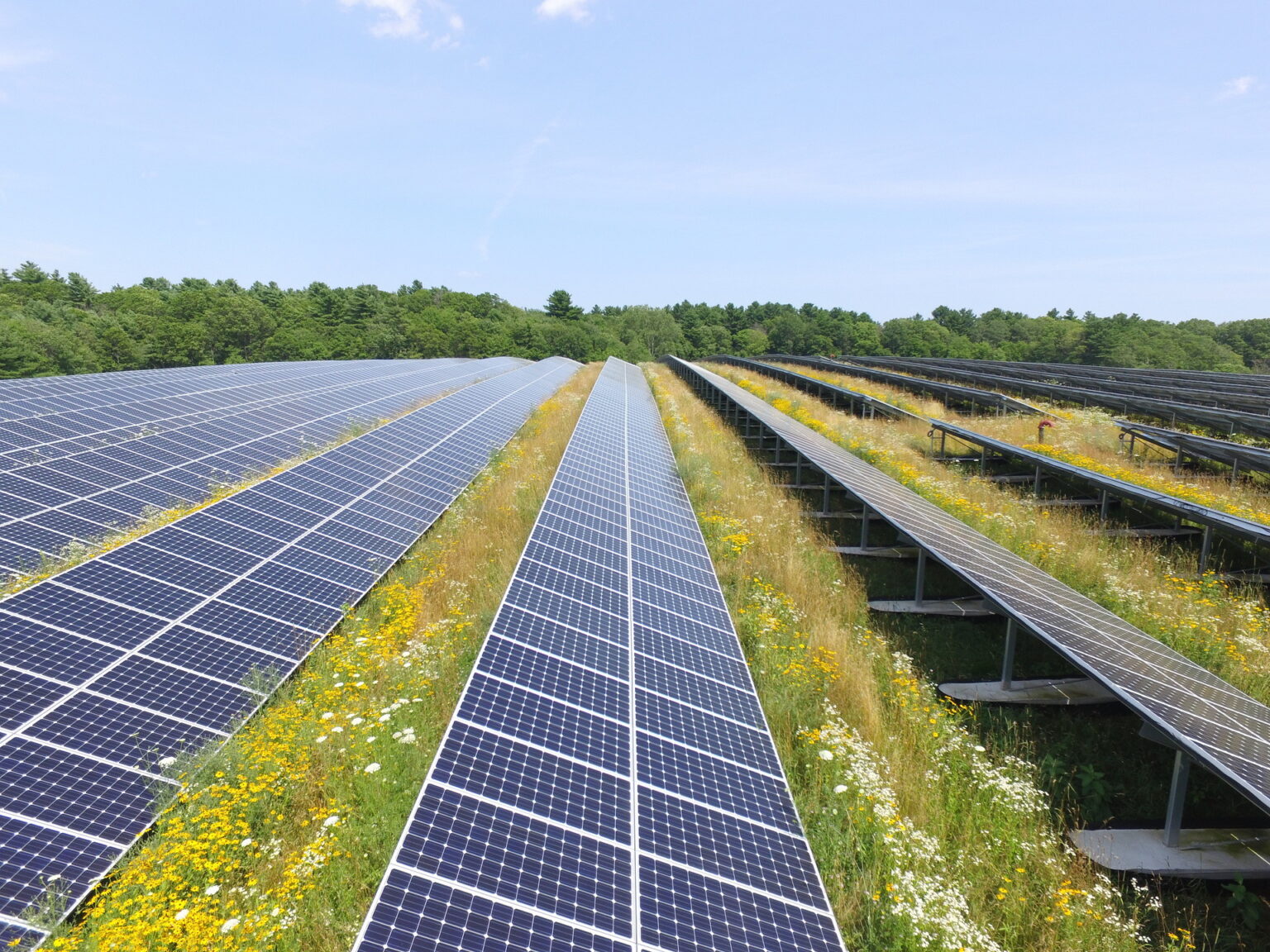Are solar farms the answer to our growing energy needs?
Harnessing the power of sunlight through photovoltaic cells, solar farms have emerged as a prominent solution for large-scale renewable energy generation.
With their ability to convert sunlight into electricity and integrate it into the power grid, solar farms offer not only environmental benefits but also economic advantages.
Despite challenges, technological advancements continue to enhance their efficiency and cost-effectiveness.
But how can we ensure successful implementation?
Let’s explore the potential of solar farms as large-scale renewable energy solutions.
Energy Generation
Solar farms harness sunlight through photovoltaic cells to generate electricity, converting it from direct current to alternating current for use in the power grid. The efficiency of solar panels plays a crucial role in determining the amount of electricity generated. Improvements in solar panel efficiency have led to higher energy yields and increased cost-effectiveness of solar farms.
Regular maintenance is essential to ensure optimal performance and longevity of solar panels. This includes cleaning, inspection, and repair of any damaged components.
Solar farm financing is a key consideration for project developers. Various financial models, such as power purchase agreements and government incentives, help make solar farms economically viable.
The scalability of solar farms allows for their deployment in various sizes, from small-scale installations to large utility-scale projects. However, regulations governing solar farms differ across regions and may impact their development and operation. It is important for solar farm developers to navigate these regulations to ensure compliance and successful project implementation.
Environmental Benefits
The environmental benefits of solar farms include the reduction of greenhouse gas emissions and the promotion of a cleaner and more sustainable energy future. Solar farms contribute significantly to reducing emissions by generating electricity without emitting pollutants or carbon dioxide during operation. This helps combat climate change and reduce dependence on fossil fuels, thereby promoting a cleaner and more sustainable energy future.
Solar farms play a crucial role in promoting renewable energy, as they harness sunlight, a clean and abundant resource. By utilizing solar energy, we can reduce our reliance on finite fossil fuel resources and decrease our carbon footprint. In fact, a study conducted by the National Renewable Energy Laboratory found that solar energy systems reduce greenhouse gas emissions by up to 98% compared to traditional fossil fuel-based electricity generation.
In addition to reducing emissions, solar farms also contribute to sustainability by conserving natural resources. Unlike other forms of energy generation, solar farms do not require the extraction and combustion of fossil fuels, which can have detrimental effects on the environment. By harnessing the power of the sun, we can generate clean energy without depleting valuable resources or causing environmental degradation.
Land Use
Land Use in solar farms involves the careful selection and utilization of suitable sites for the installation of photovoltaic panels. One of the primary considerations in land use for solar farms is land availability. Solar farms require a significant amount of land, and finding suitable, unobstructed sites is crucial for their successful implementation.
Another important aspect of land use is the ecological impact. Solar farms can have both positive and negative effects on the environment. On the positive side, they contribute to the reduction of greenhouse gas emissions and promote a cleaner energy future. On the negative side, the installation of solar panels can disrupt local ecosystems and impact wildlife habitats. Therefore, proper land management and design considerations are necessary to minimize these ecological impacts.
Land lease agreements also play a significant role in solar farm development. Developers must negotiate lease agreements with landowners to secure the land necessary for solar farm installation. These agreements include terms such as lease duration, rental rates, and land use restrictions.
Site selection is another critical factor in land use for solar farms. Developers must consider various factors such as solar resource potential, proximity to transmission lines, accessibility, and land topography. Proper site selection ensures optimal energy production and efficient grid integration.
Lastly, land reclamation is an essential aspect of land use in solar farms. After the end of a solar farm’s lifespan, steps must be taken to restore the land to its original state or repurpose it for other uses. This can involve removing solar panels, restoring vegetation, and implementing soil erosion control measures.
Economic Impact
The economic impact of solar farms extends beyond job creation, contributing to the local economy through incentives and subsidies. Solar farms create employment opportunities during the construction, operation, and maintenance phases. According to a report by the International Renewable Energy Agency (IRENA), the solar energy sector employed around 3.8 million people globally in 2019.
In addition to job creation, solar farms also provide financial benefits to local economies. Governments often provide incentives, such as tax credits, grants, or feed-in tariffs, to encourage the development of solar farms. These incentives reduce the financial burden on solar farm developers and make the projects more economically viable. For example, in the United States, the Investment Tax Credit and the Production Tax Credit have played a significant role in promoting solar energy development.
Moreover, solar farms can stimulate local economies through increased tax revenues. As solar farms generate electricity and contribute to the power grid, they may be subject to property taxes, sales taxes, and other forms of taxation. These tax revenues can be used to fund local infrastructure projects, education, and other public services, thus benefiting the community at large.
Technological Advancements
Advancements in solar technology have revolutionized the efficiency and cost-effectiveness of solar panels in large-scale renewable energy solutions. These advancements have been driven by ongoing research and development in the field.
One key aspect of improvement is the increased efficiency of solar panels. Modern solar panels can now convert a higher percentage of sunlight into electricity, resulting in greater energy output for a given area. This improved efficiency allows solar farms to generate more electricity, making them more competitive with traditional energy sources.
Another area of advancement is the reduction in the cost of solar panels. Innovations in manufacturing processes and material selection have led to significant cost reductions. This, coupled with government incentives and subsidies, has made solar farms more economically viable. Durability enhancements have also played a crucial role in the success of solar farms. Panels are now designed to withstand harsh weather conditions, ensuring their longevity and reducing maintenance costs.
Innovative designs have further enhanced the effectiveness of solar farms. Floating solar panels, for example, have enabled the utilization of water surfaces, increasing the availability of suitable land for solar farm development.
In the future, there are promising prospects for further technological advancements in solar technology. Research is focused on improving the efficiency of solar panels, developing new materials, and exploring energy storage solutions to overcome the challenge of intermittency.
Grid Integration
To ensure a stable and reliable power supply, solar farms are seamlessly integrated into the existing electricity grid. This integration involves various aspects, including smart grid integration, energy storage solutions, grid stability, renewable energy integration, and power grid optimization.
Smart grid integration plays a crucial role in effectively managing the integration of solar farms into the grid. It involves the use of advanced communication and control technologies to monitor and manage the flow of electricity between the solar farms and the grid. This allows for real-time monitoring of energy production and consumption, enabling efficient grid management and optimal utilization of renewable energy resources.
Energy storage solutions are also important for grid integration. Solar farms often generate excess electricity during periods of high sunlight, which can be stored in batteries or other energy storage systems. This stored energy can then be used during periods of low sunlight or high demand, ensuring a consistent power supply and grid stability.
Grid stability is a key consideration when integrating solar farms into the grid. The intermittent nature of solar energy production can impact the stability of the grid, as sudden changes in power generation can cause voltage fluctuations and frequency deviations. Therefore, grid operators must carefully manage the integration of solar farms to maintain stability and ensure reliable power supply.
Renewable energy integration involves the seamless integration of solar farms with other renewable energy sources, such as wind farms or hydroelectric power plants. This integration allows for a diversified and balanced energy mix, reducing reliance on fossil fuels and promoting a more sustainable energy future.
Power grid optimization is another important aspect of grid integration. By optimizing the power grid infrastructure and operations, such as upgrading transmission lines and implementing advanced grid management systems, the efficiency and reliability of the grid can be improved. This optimization enables the effective integration of solar farms and other renewable energy sources, maximizing their contribution to the overall energy supply.
Challenges
One of the challenges faced by solar farms is the intermittency of energy production. Solar energy is dependent on sunlight, which is not available 24/7. This intermittency poses a challenge for grid integration and requires effective intermittency management strategies.
Another challenge is the manufacturing impact of solar panels. The production of solar panels involves the use of various materials, including rare earth elements and heavy metals, which can have environmental implications. Proper management and disposal of these materials are crucial to minimize the manufacturing impact.
Public perception is another challenge for solar farms. Some communities may have concerns about the visual impact of solar farms or the use of agricultural land for solar installations. Effective community engagement and communication are essential to address these concerns and gain public acceptance.
Regulatory hurdles can also pose challenges for solar farms. Policies and regulations related to land use, grid connection, and permitting can vary across regions, making it difficult to navigate the regulatory landscape. Streamlining the regulatory process and providing clear guidelines can help overcome these hurdles.
Lastly, wildlife conservation is an important consideration for solar farms. The installation of solar panels can disrupt natural habitats and migration patterns of wildlife. Implementing measures such as wildlife-friendly design and habitat restoration can help mitigate the impact on wildlife.
Community Engagement
In the context of solar farms as large-scale renewable energy solutions, community engagement plays a vital role in ensuring successful project implementation and public acceptance. Addressing concerns and involving the public in the decision-making process are essential for building trust and gaining support. Public involvement in the early stages of project development allows for the identification and resolution of potential issues, ensuring that community concerns are appropriately addressed.
Information sharing is a key component of community engagement. Providing accurate and transparent information about the project’s benefits, impacts, and mitigation measures helps educate the public and dispel misconceptions. This information should be easily accessible and communicated in a manner that is understandable to the local community.
Community benefits should also be highlighted to garner support. Solar farms can bring economic opportunities, such as job creation and increased revenue for the local economy. Moreover, solar farms contribute to environmental sustainability by reducing greenhouse gas emissions and promoting cleaner energy sources.
Local participation is crucial for ensuring that the solar farm aligns with the community’s needs and aspirations. Engaging with local stakeholders, including residents, businesses, and community organizations, allows for their input and involvement in decision-making processes. This collaboration fosters a sense of ownership and empowers the community to contribute to the project’s success.
Conclusion
In conclusion, solar farms have emerged as a prominent solution for large-scale renewable energy generation. They offer significant environmental benefits, positive economic impacts, and advancements in technology.
Despite challenges such as intermittency and environmental concerns, community engagement plays a crucial role in their successful implementation. By harnessing sunlight through photovoltaic cells, solar farms contribute to the reduction of greenhouse gas emissions and combat climate change.
Through proper land management and design considerations, their impact on local ecosystems can be minimized. Overall, solar farms are a promising and sustainable energy solution for the future.

